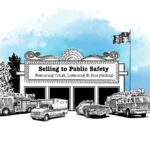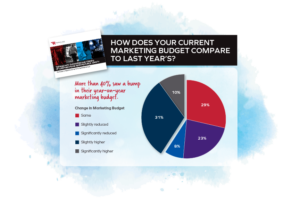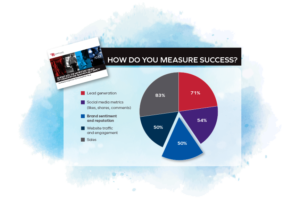
Hockey legend Wayne Gretzky once said: “Skate to where the puck is going, not to where it has been.”
It’s an adage that inspires forward thinking in the sports world, but also resonates with the leadership topic of marketing budgets.
Think of the proverbial puck as your company’s bottom line. You can’t rely on routine plays that have won the game in the past. You have to continuously skate ahead of the curve to score future revenue goals.
This forward-thinking mindset is especially needed when strategizing marketing budgets for public safety—an essential industry that is always scaling to meet the demands of public health.
What factors affect public safety spending? How will that inform my marketing budget?
We can help you answer these questions. Read on to learn how to get your organization on track with a marketing budget that aligns with growth priorities and customer needs.
Realistic marketing budgets require research
It’s important to look at the historical data of how marketing dollars have been most impactful and use those lessons to support future sales and growth goals. If you don’t have a track record to reference for your company’s marketing spend or the amount of investment in marketing for a leading product, industry benchmark data can be a starting point.
The 2020 Chief Marketing Officer Survey, detailing data from top marketing executives in a variety of industries, reports that companies spend an average 11% of their overall budgets on marketing, including salaries and hard costs. Conducted annually, this research is a steady pulse on marketing spending, and even provides insight on what slices of the budget pie are devoted to traditional and non-traditional marketing channels. It also provides trends on overall line item budgeting, including labor and support tools.
Other helpful data can be found at the Risk Management Association (RMA), formerly Robert Morris Associates, a not-for-profit group with a 100-year track record of providing financial data gleaned from actual financial statements of small and medium sized businesses. They provide benchmark figures broken down by company size and sector. This can help reference how your budget stacks up against other similarly structured businesses and by industrial classification codes.
In general, these sources mirror our experience. We conducted a recent industry review and found that 47% of all companies serving the public safety sector had annual revenues of $10 million or less. Our experience is that most public safety marketing budgets will fall between an average of $500,000 and $1 million per year. Even though this is the average, generally larger companies will have more to spend on marketing and will be found dominating the conference exhibit halls with massive booths and signage in marquee locations.
Industry benchmarks aren’t “one size fits all”
While benchmark data is a great starting point to creating a targeted marketing budget, you need to adjust that research to fit your organization’s size and goals. Characteristics of your business and where you’re heading in the industry can all have a direct impact on the chunk of change you should allocate to marketing strategy.
You can supplement that data by asking questions tailored to your business and the industry it serves:
- What type of company are we? If you’re a software service company with a high degree of operating leverage you can justify spending more because your ROI is greater.
- Where are we in our company life-cycle? Startups will need to spend more than mature companies just to penetrate the market and will look to burn rates and breakeven analysis as a guide, rather than benchmark data.
- Where are we heading in the industry? Gaining market share and achieving category leadership may require greater spending for branding and thought leadership initiatives.
- What is our current objective? If your marketing and sales teams are gearing up to launch a new product or service and focused on maximizing lead generation, this too will lead to an increase in spend.
- Are we investing in new tools? Implementing new marketing solutions like integrating a marketing automation platform with your sales funnel are large spend areas to consider as well.
Marketing budgets through a public safety lens
So, your research phase is complete and you’re ready to apply it to your role in the public safety world. Now is the time to fine-tune your budget by considering factors unique to this market. In our long-standing experience working with public safety organizations, we’ve observed that it’s an industry more resilient than most. And that means budget decisions are vital to its purpose of protecting communities.
The health of public safety agency budgets determines how much they’re going to be able to potentially spend on your product or service. Factors that determine this include:
- Government funding increases during market downturns to support the economy. The recent global crisis has led to a steady increase in federal spending topping billions and provides relief to state and local governments and, in turn, public safety.
- Local and state spending can anticipate some budget cuts, but even so, a recent survey of 2,100 cities revealed some of the resiliency of the market. For example, 73% of cities surveyed planned no salary reductions and nearly 50% said there would be no impact on local police due to forecasted revenue shortfalls.
- Budget shortfalls can be delayed due to the impact to local government budgets. However, they are somewhat buffered since income, property tax and state aid are not always immediately affected. The same survey noted that revenues based on consumer spending such as sales tax, fees and permits are projected to fall much further.
- Essential services include public safety disciplines. Often quoted in the trade media, EMS, fire and law enforcement agency budgets are a major spending area comprising as much as 60% of city budgets. We’re already hearing of agencies that are starting to cut budgets, but one thing is certain—the public’s need for health and safety services will go unabated.
Even though there will be some belt tightening for public safety budgets, these factors help prop up spending for the public safety market as a whole. And simultaneously build resilience to potential economic impacts down the road.
Likely budget priorities for public safety
In previous downturns, public safety was impacted, but not to the degree of other sectors—it was less of an initial drop, a shallower bottom and the industry re-emerged at the same pace as the economy at large. This trend can provide some insight into priorities, including:
- Types of agencies: Public safety has many service delivery models including private, non-profit, volunteer and government. What we’ve found is that for-profit agencies tend to scrutinize budgets sooner and cut more deeply. There is a strong regionalization effect, so you need to be aware of the types of agencies and budget constraints for various parts of the country—especially if you’re a regional player.
- Salaries and personnel: It’s important to understand what’s going on with your customers. The largest spending category for public safety is staffing, so it’s a natural place to trim. Agencies will look to reduce new hiring and will leave vacated positions open. Depending on the service model, other cost cutting measures are likely to affect operations. For example, in the past, EMS has seen pressure to use more volunteers, to reduce ALS and to conduct rolling service coverage (brown-outs).
- Capital expenditures: Capital expenditures are big ticket items that will get further budget scrutiny. The tendency is to delay purchases such as new facilities, major tech upgrades and equipment such as vehicles. While some argue that patching together dilapidated equipment ends up costing more than replacing, it’s still spending that will be watched. In recent years, subscription-based services such as SaaS models have made it easier to upgrade without large budget outlays, and we can expect more in the future.
- Like to have vs. need to have: Is your product solving a burning problem for public safety or is it of the “like to have” variety? Things that don’t get cut are those that are essential to public safety’s life safety mission; think indispensable equipment, services and perishable single-use products.
- Replacement/cost savings: Products and services that are necessary but could be done in a less costly fashion will get special consideration. For example, in years past agencies have used more virtual and online training courses to offset more costly in-person classroom training. The more your product can focus on proving its efficiency and ROI, the better.
- Risk aversion: Given financial constraints, agencies are less likely to take chances with unproven products and services. Indeed, research shows that trusted market-leading brands weather downturns better than most. All things being equal, agencies will go with what works. For new products and services entering the market, it’s important to make compelling arguments to convince agencies to switch providers.
Keep your eye on the future
We’ve learned that a healthy, realistic budget is key to successfully implementing marketing strategies that improve your bottom line. And as a leader in the public safety arena, it’s important to lead your organization into the future; don’t just focus on what you can do in the here and now. Remember to do your homework in the upfront. Analyze the research and apply it to your company’s position in the marketplace. Fine-tune how you market your product to customers in a way that’s compelling and proves its worth.
Keeping your focus on where the proverbial puck is going will get your company to where you want and need to be–amidst downturns, challenges and everything in between.
Related Posts
-
Selling to public safety is not the same as selling in other industries. Discover 3…
-
At the RedFlash Group, we think a lot about purpose. Maybe it’s because our clients…
-
In the busy world of marketing, it can be tempting to push projects forward to…









 The RedFlash Group is a GSA Contract Holder under Schedule 541, Advertising and Integrated Marketing Solutions
The RedFlash Group is a GSA Contract Holder under Schedule 541, Advertising and Integrated Marketing Solutions